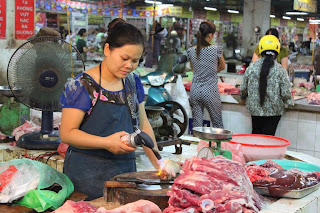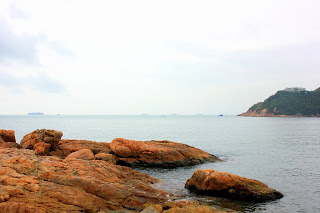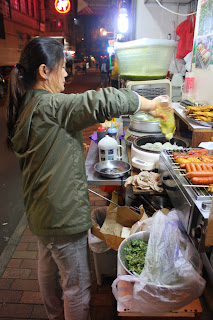Vietnamese people prefer street food over restaurants. They know which street or place is specialized in which food. Eating street food is definitely an experience, it is fresh, delicious and cheap. The best thing about it is that at the same time it provides you an opportunity to get closer to Vietnamese culture and see how local people live.
Vietnamese food is very different from Western food. Vietnamese people always use fresh ingredients. If you go on a food market, you will see farmers bringing their home grown fruit and vegetables. I was shocked when I saw that they sell meat on streets without using fridge to store it in. They bring pieces of meat and wait for somebody to buy it, or they just bring a live animal. Also, Vietnamese people try to avoid buying imported fruit and vegetables, it is from such a vital importance for them that food is home grown and fresh.
Second thing that differs Vietnamese food from Western food is that Vietnamese food is very light. They try to use as less oil as possible. No wonder that Vietnamese cuisine is known as one of the healthiest cuisines in the world. Moreover, interesting fact is that Vietnam is one of the skinniest nations in the world.
Standard of living in Vietnam is very low and prices of ingredients and food are very cheap. Cooking and eating is a very important activity, which reflects the Vietnamese lifestyle. Since they have to save money, there is no food ingredient that is wasted. That actually means that they use absolutely every part of a cow or a pig, and the same goes for vegetables. Many times I was surprised when I saw them cooking some vegetables or flowers that in Europe we use only as decoration. Even though their food is very simple, that doesn't mean it is not delicious. They know how to mix together simple ingredients and make a delicious and healthy meal out of it.
Probably an interesting information would be to say what is the range of prices of food in Vietnam. You can get a really good street food for 1-3$. If you go to a restaurant, food will be a bit more expensive, for example from 2-6$. In my personal opinion, street food is always more delicious than restaurant food, probably due to the fact that they use fresh ingredients and are always busy.
Vietnamese food differs from region to region. It can be divided to North, Central and South region. I live in the North, which is very influenced by China. Therefore, very popular food here are noodles. Most popular dish in Northern Vietnam is noodle soup and there is a huge variety of them, each with distinct influences, origins and flavors.
My favorite noodle soup is Pho Bo Sot Vang (beef au vin rice noodle soup), which is typical for Hanoi region but originates from France. Vietnamese people eat meat noodle soups for lunch, dinner or breakfast. Yes, breakfast, and keep in mind that they wake up around 5 or 6 AM!
Second very common dish in Vietnam is Hot Pot, which was adopted from Thailand. Hot pot means that you actually get fresh ingredients and a hot pot to cook them by yourself. Usually many people gather together to eat hot pot when they want to celebrate something, and then they drink shots of rice wine. Rice wine is actually a strong liquor made of rice, it has nothing to do with wine.
One of my favorite Vietnamese dishes is Bun Cha. Bun Cha originates from Hanoi and is usually served only for breakfast and lunch. The best Bun Cha you will get on street, not in a restaurant. It is actually a grilled pork soup served with side of noodles and fresh herbs, which you put in the soup.
Vietnamese coffee is a story for itself. Some people love it, some people hate it. It is very bitter and usually is served with condensed milk and ice. For people that love ice coffee, I'm sure this would be a good combination.
Another very popular dish in Hanoi is Bun Dau Mom Tom (noodles with tofu and shrimp paste). First time I had it in a restaurant and it was ok, but second time some local people took me to a local place and I really tasted the difference. It was way more delicious and cheaper in the local place.
Restaurant:
Local place:

Sticky rice is also a very popular meal. There are more types of sticky rice, on the picture below is a sticky rice in bamboo.
The following two dishes are my absolutely favorite dishes in Vietnam, probably because they are so refreshing and different.
Or, if Vietnamese people invite you to their house to have spring rolls, it actually means that you will have many plates with meat and vegetables in front of you to make your own spring rolls.
My second favorite Vietnamese dish is Ba Nh Xeo (Vietnamese pancake with shrimp and pork). It is made of rice flour, water, turmeric powder, stuffed with slivers of fatty pork, shrimp, diced green onion, and bean sprouts. They are served with side of rice paper and herbs, so you roll your pancake into it and dip it into sweet and sour diluted fish sauce. Desserts in Vietnam are different from everything what I was used to eat as a dessert before. They don't eat chocolate as a dessert. I read somewhere that Vietnamese are accustomed to little milk and cheese, and many cannot produce the enzymes needed to properly digest dairy foods. Therefore, Vietnamese desserts include a lot of fresh fruit and are very light.
Lot of dessert names start with Che, which is a Vietnamese term that refers to any traditional Vietnamese sweet beverage, dessert soup or pudding. Che can be made with mung beans, black-eyed peas, kidney beans, tapioca, mung bean, jelly (clear or grass), fruit (longan, mango, durian, lychee or jackfruit), and coconut cream. Other types are made with ingredients such as glutinous rice, salt, aloe vera, seaweed, lotus seed, sesame seed, sugar palm seeds, taro, cassava and pandan leaf extract.
Che Thap Cam (beans, jelly and glutinous rice with coconut milk and ice)
Che Ba Ba (sweet potato and wheat flour in warm coconut milk)
Che Hat Sen (lotus seed dessert soup)
Com Xao Dua (fried green rice flakes with shredded coconut)
Tau Pho (sweet tofu)



















































































































































